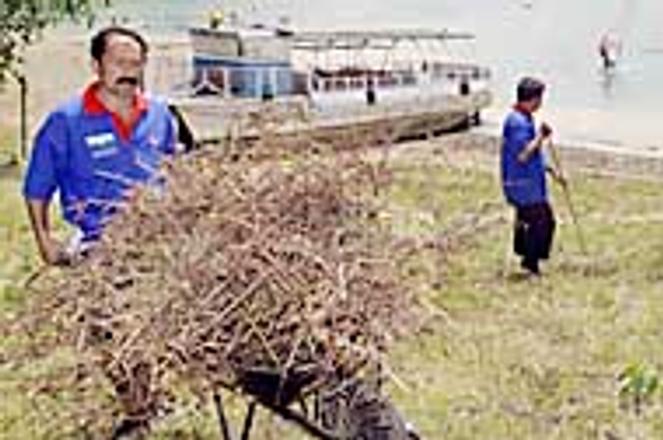VEĽKÁ Domaša lake will again be a tourist mecca with Phare help.photo: TASR
DESPITE the increased availability of European Union funds for developing Slovakia's long-struggling east, the country continues to show major differences in investment and development among its eight regions.
The Bratislava area has enjoyed the lion's share of foreign investment throughout Slovakia's decade-long history, as well as the country's highest wages, lowest unemployment, and GDP-per-capita levels equal to the EU average. In contrast, the eastern Prešov and Košice regions continue to suffer unemployment levels of more than 25 per cent.
However, with EU approval in early October of a Sk200 million ($4.5 million) project aimed at developing the Veľká Domaša area east of Prešov, along with four other projects in Slovakia's east, regional development has been given a solid boost.
The Domaša project is aimed at improving the infrastructure around the Veľká Domaša dam as well as attracting tourists to the dam's large artificial lake. It is being made possible by funding from the EU Phare programme for Economic and Social Cohesiveness (ECOSOC), and is supervised by Slovakia's Ministry of Construction and Regional Development.
"We assume that the project's implementation could start sometime in the next year," said Július Slovák, head of Slovakia's Agency for Regional Development Support under the Construction Ministry.
However, securing the funds for the project was no easy task. Domaša organisers say the detailed project design required by European Commission (EC) funders took years to prepare and taxed local administrative capacities to the limit.
"The preparation was really demanding. Because of changing requirements we processed six alternative plans, starting in the spring of 2000," said Vladimír Bodnár, head of the regional development section at the Vranov nad Topľou District Office in east Slovakia.
"The final version was submitted to the Construction Ministry in October 2000, where it was chosen as part of a group of 10 projects out of 118 proposals to be sent to Brussels," he added.
Although 10 regional development projects were sent to the EC for evaluation, only five have reached the final financing stage, highlighting what development critics have long called Slovakia's failure to take advantage of funding opportunities.
While there are many factors to Slovakia's perceived inability to capture funding, critics say that the biggest problems are the complicated EU application procedures, scanty local administrative capacity and widespread inexperience in dealing with grant projects.
Last November, the EC released a report showing Slovakia in last place among Visegrad Four countries in fund utilisation, having used only 15 per cent of the development aid for which it was eligible. A number of projects coming in shortly before funding deadlines later improved that ratio to 50 per cent.
"I think it is time to sound the alarm. Half the time allotted for closing contracts has passed, but only 10 per cent of proposed projects have been signed," said Dieter Thiel, head of the European Delegation's section for handling Phare and other development programmes in Slovakia, at the January signing of agreements enabling Slovakia to use EU funds.
"By not using EU pre-accession funds, Slovakia is creating a few problems," said Zsolt Lukáč, general director of regional policy at the Construction Ministry.
"One of the shortcomings we have seen, and are attempting to remove, is the country's lack of knowledge about the correct way to prepare projects for approval," he continued.
In an attempt to remedy the situation, the ministry has started an institutional project-building programme aimed at preparing specialists for work in regional administrations, said Lukáč.
"Currently, we are directing this programme at regional government offices throughout the country, so we can prepare people there," he said.
"This is our vision: to give regions the most opportunities possible during the pre-accession period."
By building administrative capacity in the country's eight regional governments, said Lukáč, more regions will be able to implement more projects, bringing benefits for the whole of Slovak society and particularly for areas currently underdeveloped and suffering from high unemployment.
All five projects recently approved by the EC are aimed at developing areas in east Slovakia and will be co-financed by Slovak regional governments.
Mária Kadlečíková, Deputy Prime Minister for European Integration, said that the Veľká Domaša project is a perfect fit for the Prešov region, which has 28 per cent unemployment but underused capacities in the tourism sector.
Tourist visits to the area have been dropping steadily from past averages of 750,000 annual visitors to 400,000 in 2001. Officials said moves are now afoot to reverse that decline.
"Two American businessmen have shown interest in investing in Slovakia with the goal of building tourist centres and golf courses. We will locate at least one of them in east Slovakia," said outgoing Economy Minister Ľubomír Harach after meeting with Domaša project organisers.
"We can definitely look forward to the improvement of recreation facilities at Domaša," added Bodnár.


